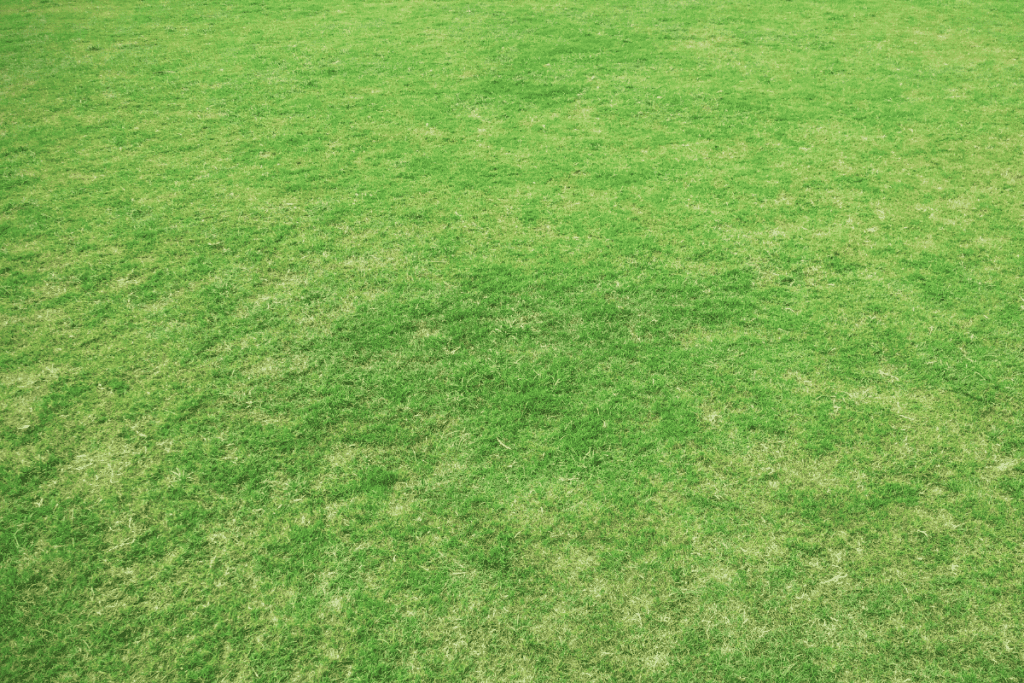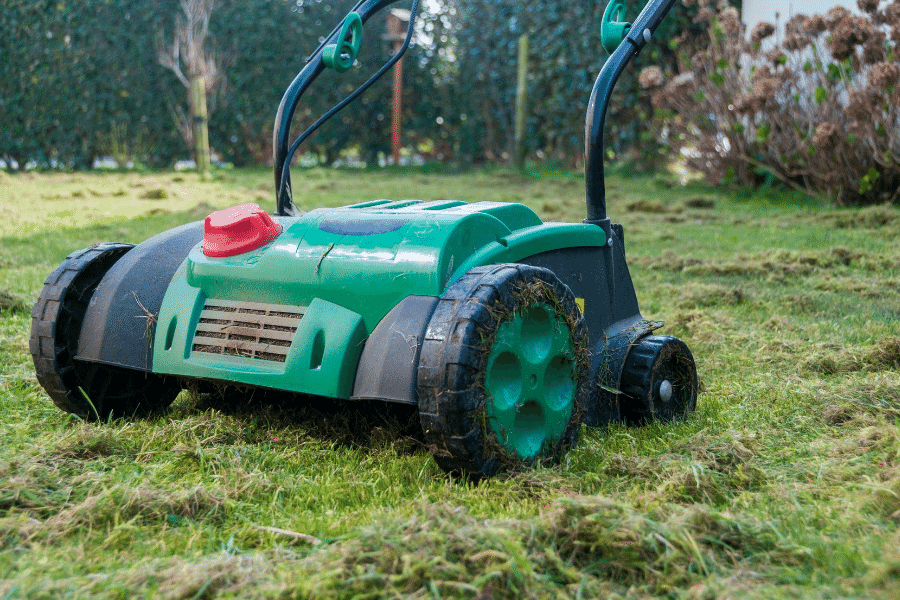Many homeowners will do whatever they need to maintain a perfect lawn.
One of the aspects of lawn care is providing your grass with enough water to keep it lush and green.
It is more challenging to keep a green lawn during drought conditions, especially if water usage restrictions in your area.
But how do you keep your grass green without watering it?
Raising your lawnmower blade, regular mulching, proper soil aeration, and using organic fertilizer will allow your grass to retain moisture and keep grass green without watering as much. Planting native, drought-tolerant grass in your yard also reduces the amount of watering and maintenance your lawn needs.
Keep reading to learn more about how to keep your grass green without watering it and why installing a rain barrel system may be a good choice for you.

Table of Contents
Raise The Blade On Your Lawn Mower
Taller grass will form a deeper root system, allowing the plant to absorb more nutrients and moisture.
The longer grass blades also provide some shade to prevent water evaporation from the soil and protect the roots from the sun’s heat.
No matter what type of grass you have in your yard never cut more than one-third of the length of the grass blade.
Cutting your lawn too short will make the grass blades more susceptible to being damaged by sunlight.
Shorter grass will also have shallow root growth, making it difficult to absorb enough water and nutrients to thrive.
As a result of overcutting, your lawn will begin to have bare spots, and your grass will be yellow or brown.
Check out these tactics for turning yellow grass green like the pros.
For a green, healthy lawn, it is best to let the grass grow to a height between 3-4″ inches.
By raising your lawn mower blade the next time you mow, you will be able to reduce your watering sessions.
Longer grass also has the added benefits of being softer under your feet and offering more cushion from falls.
Mulch Your Lawn
A thin layer of mulch on your lawn will not only help to prevent water evaporation but will nourish your grass as well.
However, the type of mulch you would use for your grass differs from the cedar mulch used in flower beds.
For your lawn, the only thing you need for mulch is the grass itself.
The easiest and most inexpensive way to regularly mulch your lawn is to leave the grass clippings after you mow.
Grass clippings are rich in nitrogen, potassium, and phosphorus, and these nutrients are released back into the soil as decomposition takes place.
Specially designed cutting blades on some lawn mowers will cut the grass clippings into very small pieces, so look for a mulching option when purchasing a lawnmower.
If the grass clippings clump up or are spread too thickly on your lawn, the grass underneath will not be able to get enough nutrients or water.
Use a metal rake to spread the grass mulch evenly across your yard for the best results.
Using a grass mulch on your lawn will also help to prevent thatching.
Thatching is the accumulation of dead grass and other organic matter, forming a thick layer on your grass.
If a lawn is not dethatched regularly, the buildup will prevent your grass from receiving the water and nutrients it needs to thrive.
Check out our answer to if dethatching blades actually work.
Avoid mulching wet grass, as the moisture will cause the grass clippings to clump together.
During the peak of the growing season, you may need to remove excess grass mulch from time to time.
More frequent mowing means the grass mulch will not have ample time to decompose, and adding more on top will cause it to become too thick.
Aerate the Soil in Your Yard

Soil aeration creates a way for water to efficiently reach the root systems of your grass.
If the soil on your lawn is very hard and compacted, it will significantly benefit from proper aeration.
With yearly soil aeration, your lawn will stay greener with less frequent watering.
A lawn aerator makes the job quite easy, and the type you use will depend on the condition of your lawn.
Types of Lawn Aerators
The three most common types of soil aerators are spike, plug, and slicing aerators.
These are available as small manual tools or larger versions that are towed behind a tractor.
Garden centers usually have soil aerators available for rental, or you may hire someone to aerate your lawn for you.
A plug aerator works by using a hollow tube to remove a cylinder of soil from the ground.
A spike aerator punches a hole in the ground without removing a plug of soil.
Both types of aerators serve the same function by creating a passage several inches into the soil for water to travel directly to the grass roots.
Take care when using spike aerators because overdoing it may cause the soil around the holes to become compacted.
If your soil is very compacted, a plug aerator will work best for your lawn.
There are also slicing aerators, which use blades to cut into the soil.
Slicing aerators leave the soil in place and are less likely to compact the soil.
When to Aerate Your Soil
Soil aeration only has to be done once per year to be effective, usually in the spring.
Never aerate your lawn when it’s dormant.
The best time to aerate cool-season grasses is in early fall or early spring.
Warm-season grasses benefit from soil aeration during late spring or early summer.
Aerate the soil at least one day after a watering session or soaking rain.
The water helps the aeration process, which is more difficult to do when the soil is dry.
If there has been heavy rain, wait until there is no standing water on your lawn.
After you have aerated your lawn, it is the perfect time to overseed or fertilize.
Use Organic Fertilizer
Switching to organic fertilizer, such as compost, is another way to keep your grass green without the need for frequent watering.
Unlike chemical fertilizers, organic fertilizers do not need to be watered in to be effective.
Organic fertilizers also do not need to be immediately watered after application to prevent burns to your grass.
Organic fertilizers work by composting rather than being dissolved by water.
This means the fertilizer will break down into the soil and keep nourishing your lawn long after it has been applied.
Because of the organic material added to the soil, your grass will stay green without needing a lot of water.
Many people stop fertilizing their lawns during drought conditions.
Chemical lawn fertilizers quickly increase grass growth, which requires more frequent mowing and watering.
Organic fertilizers are slow-acting over a long period, allowing you to greatly reduce your lawn’s watering needs.
As they start breaking down, organic fertilizers release nutrients into the soil and improve the soil structure and allow it to absorb more nutrients and moisture.
Organic fertilizers are also better for the environment, as they do not leave behind any potentially toxic chemical buildup.
Organic fertilizers are composed of plant and animal waste, as well as powdered minerals.
Chemical fertilizers tend to be less expensive, but they do not offer the long-term benefits of organic fertilizers.
Rethink Your Landscaping
If you live in an area prone to drought conditions or simply want to save money on your water bill, starting by planting a drought-tolerant grass type is best.
Most drought-resistant grass varieties are warm-season types, such as:
- Kentucky bluegrass
- Zoysia grass
- St. Augustine
- Tall Fescue
These grasses work very well at heights of 3-4″ inches, and they are adapted to retain moisture by having a strong root system.
The taller grass blade height also helps prevent broadleaf weeds and clover from growing and stealing nutrients from your green lawn.
In addition to planting hardy grass types, you may also want to consider decreasing the overall size of your lawn.
Smaller areas of grass are much easier to water and maintain.
Add stone walkways, or create hardscapes with pebbles and drought-resistant shrubbery to break up large grass areas.
Decorative grasses, such as blue panic grass, may be planted alongside pathways and other plants.
Blue panic grass grows tall, it does not need much water thanks to its robust root system, and it does not have to be mowed since it is decorative.
Creating a patio area with minimal plant life is another excellent way to decrease the size of your lawn while getting the most from your outdoor space.
Install A Rain Barrel System To Save Water
A rain barrel system works by collecting rainwater from your drain spouts to irrigate your lawn later.
Even kits are available to hook up a sprinkler system directly to the rain collection barrel.
Rain barrels can collect large amounts of water, and they are not susceptible to any limited water usage bans your city may have in place during dry conditions.
Even when there are no water restrictions, a rain collection barrel is an earth-friendly way to save on your water usage and budget.
Commonly Asked Questions
How long can grass go without watering?
When grass is not watered, it will go dormant.
The grass will appear brown during this dormant period, but it will turn green and be revived once proper growing conditions are reintroduced.
In general, grass will survive for up to six weeks without adequate water, but this also depends on the condition of the soil and the surrounding environment.
If drought conditions last longer than four weeks, there may be permanent damage to your grass.
Do not mow extremely dry or damaged grass, as this will cause even more damage and result in bare spots on your lawn.
Dry soil will not support the grass root system, and it will easily be pulled from the ground.
Do I need to water my grass?
As a general rule, most lawns need between 1-1.5″ inches of water per week.
If you are watering your lawn when it rains during the week, you may be overwatering.
Use a rain gauge to accurately measure the amount of rainfall your yard receives.
Take these rainfall measurements into account when you are deciding how much to water your lawn.
If the rainfall measurements are adequate to keep your lawn healthy and green, you will not have to water your lawn at all.
How do I make my grass green all year round?
Keeping your grass green all year may be challenging, depending on where you live.
Both cool-season and warm-season grass types will go dormant in low temperatures during the winter months.
After their dormancy, these grasses will revive and turn green again when temperatures become warmer in the spring.
However, if you live in a climate where the average temperatures are above 60° degrees Fahrenheit (15° C) during the winter, it is possible to maintain green grass all year.
Regular mowing, fertilizing, irrigation, and soil aeration will keep your grass healthy and green.
If you live in a colder climate, your best bet at having green grass all year is to plant tall fescue grass and regularly use a nitrogen-rich fertilizer.
The nitrogen will keep the top layer of grass green, even during colder temperatures.
What can I put on my grass to make it green?
Nitrogen is a crucial component to maintaining green grass.
You may use nitrogen-rich chemical fertilizer for quick results, but it is best to use organic fertilizer for more long-term effects.
Grass clippings are the cheapest and easiest way to fertilize your lawn, and they contain large amounts of nitrogen.
As the grass clippings begin to decompose, they release their nitrogen and other nutrients into the soil, encouraging healthy grass growth.